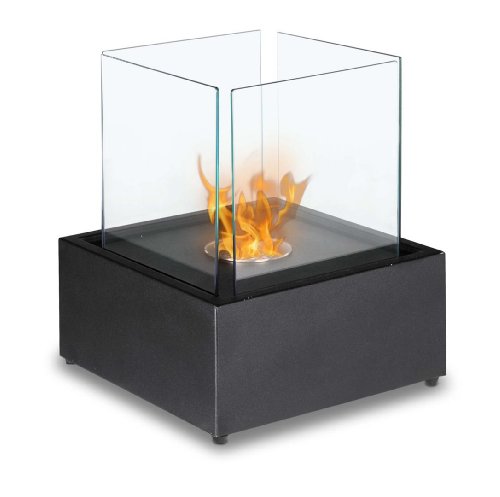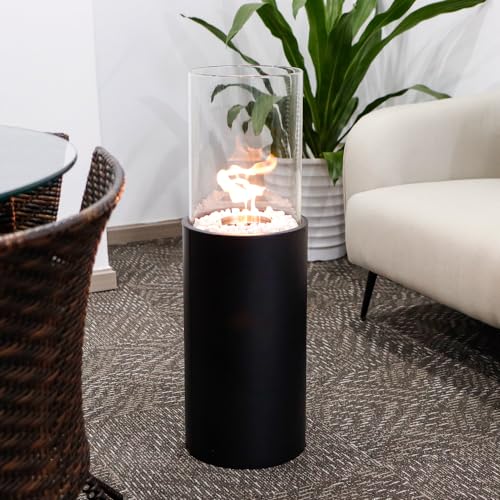Bioethanol Freestanding Stove Tips From The Top In The Business
작성자 정보
- Stevie 작성
- 작성일
본문
 Bioethanol Freestanding Stove
Bioethanol Freestanding Stovelarge freestanding bioethanol fireplace fireplaces made of bioethanol are a great way to create your dream home. Installation is easy and does not cause disruption to your home since they don't require a chimney or flue.
Choosing the right stove requires balancing initial investment with long-term fuel costs. You can calculate your fuel costs by checking specifications such as the burner reservoir size and the flame's height.
Freedom of Place
A bioethanol stove is a modern elegant alternative to traditional wood-burning fireplaces and wood burners. They are a great option for many homes and rooms because they don't need a chimney. They burn clean, liquid ethanol fuel that doesn't emit harmful smoke or fumes. This makes them a versatile and convenient heating option that can be moved around the room without affecting your home's decor.
The versatility of a bioethanol fire that is freestanding allows you to create a warm and elegant focal point in any room such as an accent or feature piece in your living space or as an intimate backdrop to host guests. The size of the flame can also be adjusted to suit your preferences. A wider flame creates more heat, while smaller flames emit more of a romantic glow. The color and the appearance of the stove will affect the visual impact. Colors that are neutral like white or black can be used with many interior styles. The bolder shades can stand out or complement existing furniture.
Installing bioethanol stoves is a breeze. They can be mounted in different ways, including wall-mounted models with plug-and-play functionality that can be installed within less than a half hour to elaborately designed stoves that are ceiling or floor standing bio ethanol fireplace-mounted. Some models come with remote controls that allow you to control the heat and flames right from your sofa or armchair.
Another aspect to consider when choosing a stove made of bioethanol is the price and long-term maintenance. The initial investment may be higher than a conventional fire, but the costs over time are typically lower as the ash and logs don't need to be cleaned or replaced frequently. You should also consider the amount of bioethanol that your stove will use per hour. This will affect the frequency at which it must be refuelled, and how much total operating expenses you'll pay over the course of.
Get advice from a professional prior to installation if you are considering a bioethanol stove. This will ensure that your stove is properly positioned and set up for maximum safety and efficiency. They can also advise on the best way to maintain your stove, keeping it looking and operating as new for as long as is possible.
Aesthetics
Comparing bioethanol fires to traditional fireplaces or stoves it is incredibly simple to operate. All you have to do is fill the burner tray with the liquid ethanol fuel and then ignite it. After it has been lit, you can adjust the intensity and height of the flame to achieve your desired look. As it burns, the flame creates an amazing warm glow that instantly transforms any room and makes it feel cosy.
There are a variety of stylish designs to choose from, making them suitable for traditional and modern homes. Some of the most popular models feature a curving window which allows you to see the flames clearly, and an integrated fireplace log holder so it appears like an old-fashioned wood burning stove. Some models, like Oslo by Henley, Oslo by Henley, are more contemporary and feature an open-flame effect. They're perfect for creating a cozy environment without hassle or maintenance.
The majority of bioethanol stoves are simple to set up and require only minimal maintenance. This is thanks to the fact that they don't produce any ash or smoke, so you won't need to clean up the dust and mess that comes when burning wood. In addition the clean burn of bioethanol fuel means you won't need to worry about breathing in toxic air pollutants or toxins.
It is important to remember that all bioethanol fireplaces do require adequate ventilation. This is because they require oxygen during combustion, and a failure to do this could result in your stove not lighting or even exploding. The majority of stoves have safety mechanisms that stop the flame in the event that oxygen levels fall too low.
It is also important that you place your bioethanol stove away from fire-prone material, such as curtains or soft furnishings. Some models have an automatic shut-off if they're left unattended too long. This helps to improve safety and reduce the risk of damage. It's best to utilize liquid ethanol instead solid fuels for your bioethanol stove. This will not only help to keep your home cleaner, but it will also save you money in the long run and minimize environmental impact.
 Efficiency
EfficiencyA freestanding bioethanol stove, also known as an bio fuel or ethanol fire fireplace, makes use of pure liquid ethanol fuel that produces real flames and heat. Their high efficiency and sleek design have made them a popular choice for modern homes looking to reduce carbon footprints as well as improve the aesthetics of living spaces. To ensure a secure, enjoyable experience, it's important that people are aware of the safety precautions as well as the manufacturer guidelines.
Bioethanol fuel is a renewable resource that can be harvested every year. It is produced by fermenting sugars and starch elements from plants like straw, sugar cane and maize. It is then put through the process of distillation to create the fuel. As the ethanol liquid burns, it creates three main by-products: heat and water vapour, and a tiny amount of carbon dioxide. These by-products don't harm animals or humans. This makes bioethanol a sustainable alternative to fossil fuels.
While the nature of the fuel makes bioethanol stoves do not emit harmful smoke or ash, they require proper ventilation to operate safely. They should only be used in well-ventilated areas and away from any flammable materials. Some bioethanol stoves come with adjustable burner trays that allow users to adjust the flame's height. This could reduce the amount of heat produced while preserving fuel.
The power output of a freestanding bioethanol stove may vary from model to model, but the vast majority have a maximum output of 1 kW. This is ideal to heat smaller spaces or as a source of heat to warm up larger areas.
Bioethanol fireplaces are a stylish, modern heating option that can increase the value of your home, while helping you save on your utility bills and chimney maintenance. By adhering to safety precautions and manufacturer guidelines, you can enjoy the beauty and warmth of a bio fire without the added cost of costly maintenance. As more people are conscious of the environmental impacts of their daily activities, the demand for products like bioethanol stoves will continue increase.
Safety
Bioethanol stoves must meet certain safety standards in order to be used as a heating solution. They don't produce dangerous byproducts such as carbon monoxide, and are safe to use in rooms with an open flame. That being said, as with any heating solution, proper ventilation is still essential to remove harmful byproducts, and to ensure optimal combustion and proper operation of the appliance. In addition, attention to the storage of fuel, the installation environment and maintenance can prevent any issues that could arise.
Another safety benefit is that, unlike gas fireplaces, an ethanol fire doesn't have a connection to a fuel line, eliminating the risk of leaks or incidents caused by conduits that are contaminated with toxic fuel. Because the fuel is liquid and follows the flame if it escapes from the burner it is able to stop a fire from spreading that could cause property damage or injury to persons.
Bioethanol fireplaces can also be an excellent alternative to wood and gas fireplaces since they don't require a chimney. They can be utilized in many different rooms and homes, such as flats, apartments and conservatories. They produce a lot of heat for their small size, and they do not emit smoke or ash. This makes them an ideal alternative to wood or other gas fireplaces.
When you are searching for a bioethanol freestanding fire there are models in an array of finishes and designs to suit your space and the style of your home. You can also shop by brand, since established and reputable brands typically have higher prices but can guarantee quality and after-sales support.
Ultimately, the choice you make will depend on the balance between your budget and long-term operational costs. Take into consideration factors like the time it takes to burn each full tank (usually five hours) as well as your fuel consumption rate, and your usage patterns. A precise estimate will aid you in determining whether the initial investment is worth it and will provide you with an idea of your monthly or annual fuel costs. Also, you should take into consideration any accessories that might require purchasing for example, remote controls for airflow or a remote.
관련자료
-
이전
-
다음
댓글 0
등록된 댓글이 없습니다.
